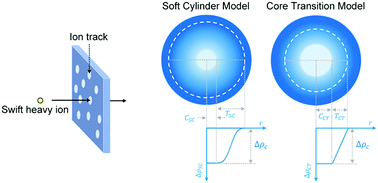SAXS data modelling for the characterisation of ion tracks in polymers
Abstract
Here, we present new models to fit small angle X-ray scattering (SAXS) data for the characterization of ion tracks in polymers. Ion tracks in polyethylene terephthalate (PET), polycarbonate (PC), polyimide (PI) and polymethyl methacrylate (PMMA) were created by swift heavy ion irradiation using 197Au and 238U with energies between 185 MeV and 2.0 GeV. Transmission SAXS measurements were performed at the Australian Synchrotron. SAXS data were analysed using two new models that describe the tracks by a cylindrical structure composed of a highly damaged core with a gradual transition to the undamaged material. First, we investigate the ‘Soft Cylinder Model’, which assumes a smooth function to describe the transition region by a gradual change in density from a core to a matrix. As a simplified and computational less expensive version of the ‘Soft Cylinder Model’, the ‘Core Transition Model’ was developed to enable fast fitting. This model assumes a linear increase in density from the core to the matrix. Both models yield superior fits to the experimental SAXS data compared with the often-used simple ‘Hard Cylinder Model’ assuming a constant density with an abrupt transition.



 Please wait while we load your content...
Please wait while we load your content...